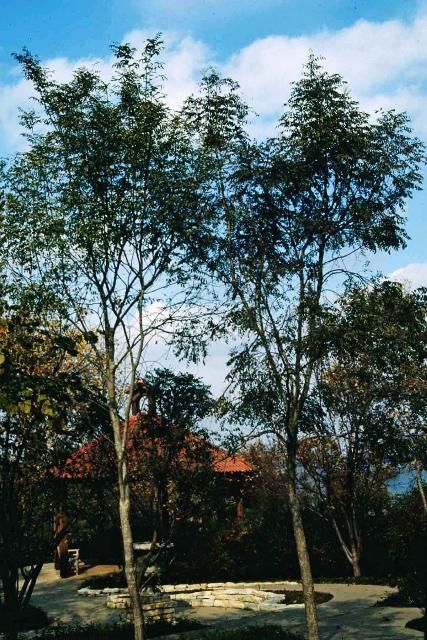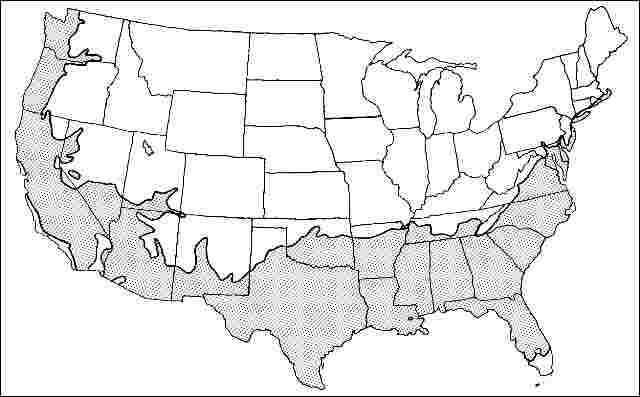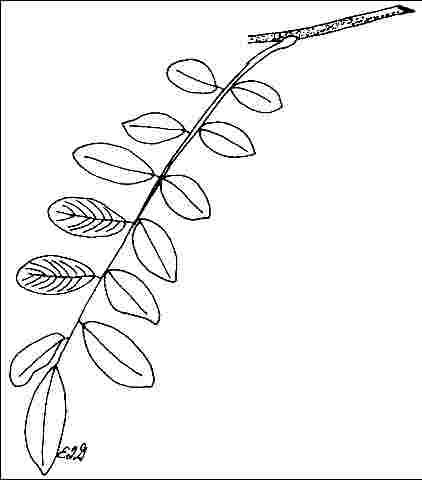Introduction
Eve's necklace, or Texas sophora, is a native North American, deciduous tree which grows moderately fast to 35 feet tall and 20 feet wide. Trees grown in the sun are often shorter. It has an upright silhouette and pinnately compound leaves. Branches often weep slightly lending a delicate texture to the tree in the sun or shade. The fragrant, white-with-pink blossoms appear in June in dense, two to six-inch-long racemes, somewhat like wisteria. The black seedpods which follow are up to four inches long, the pod tightly pinched around each encased seed, giving it almost the appearance of a string of beads, hence its common name.

Credit: Ed Gilman, UF/IFAS
General Information
Scientific name: Sophora affinis
Pronunciation: sah-FOR-uh aff-EYE-niss
Common name(s): Eves-necklace, Texas sophora
Family: Leguminosae
USDA hardiness zones: 7A through 9B (Fig. 2)
Origin: native to North America
Invasive potential: little invasive potential
Uses: deck or patio; specimen; reclamation; highway median; parking lot island 100-200 sq ft; parking lot island < 100 sq ft; parking lot island > 200 sq ft; street without sidewalk; tree lawn 3-4 feet wide; tree lawn 4-6 feet wide; tree lawn > 6 ft wide; container or planter
Availability: not native to North America

Description
Height: 30 to 35 feet
Spread: 15 to 20 feet
Crown uniformity: irregular
Crown shape: vase, round
Crown density: open
Growth rate: moderate
Texture: fine
Foliage
Leaf arrangement: alternate (Fig. 3)
Leaf type: odd-pinnately compound
Leaf margin: entire
Leaf shape: ovate, elliptic (oval)
Leaf venation: pinnate
Leaf type and persistence: deciduous
Leaf blade length: less than 2 inches
Leaf color: green
Fall color: no color change
Fall characteristic: not showy

Flower
Flower color: pink, white/cream/gray
Flower characteristics: showy
Fruit
Fruit shape: elongated, pod, or pod-like
Fruit length: 1 to 3 inches, 3 to 6 inches
Fruit covering: dry or hard
Fruit color: black
Fruit characteristics: does not attract wildlife; showy; fruit/leaves not a litter problem
Trunk and Branches
Trunk/bark/branches: branches droop; showy; typically multi-trunked; thorns
Pruning requirement: needed for strong structure
Breakage: resistant
Current year twig color: green, brown
Current year twig thickness: thin
Wood specific gravity: unknown
Culture
Light requirement: full sun, partial sun, or partial shade, shade tolerant
Soil tolerances: clay; sand; loam; alkaline; acidic; well-drained
Drought tolerance: high
Aerosol salt tolerance: unknown
Other
Roots: not a problem
Winter interest: no
Outstanding tree: no
Ozone sensitivity: unknown
Verticillium wilt susceptibility: unknown
Pest resistance: free of serious pests and diseases
Use and Management
Texas sophora often grows like a woody vine in the wild. It can be used as an understory small tree in a partially shaded location, but the crown will not be as dense as when it is grown in full sun, and flowering will be sparse. It makes a nice small tree for planting next to the deck or patio where it casts light shade. With some training and pruning to create a more uniform growth habit, the tree would become more popular.
Texas sophora should be grown in full sun or partial shade on any well-drained soil. Trees are drought-tolerant and will flower most heavily if located in full sun.
Propagation is by seed.
Pests and Diseases
No pests or diseases of major concern.